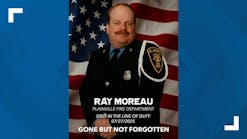NIOSH: Prohibited Drilling Led to 2018 WI Blast in LODD
Source Firehouse.com News
A natural gas leak caused by prohibited drilling led to an explosion while crews were in the blast area evacuating civilians and contributed to the 2018 death of a Wisconsin firefighter, according to a federal line-of-duty death report.
The findings are part of a National Institute for Occupational Safety and Health (NIOSH) report released earlier this month. The investigation looked at the massive gas explosion on July 10, 2018, that injured two firefighters and killed Sun Prairie Fire Capt. Cory Barr.
RELATED:
- WI Firefighter Killed in Gas Explosion
- No Criminal Charges in Fatal WI Gas Line Explosion
- Contractors Fined in WI Blast That Killed FF
- Regulators Probe Blast That Killed WI Firefighter
According to the report, crews were called concerning a natural gas leak about a block away from the fire station. Once there, they encountered resistant civilians who were unwilling to leave the area, and the incident commander requested additional personnel.
Barr and several other firefighters entered a building near the suspected leak in an effort to control utilities in the basement. Just as the firefighters were leaving, the building exploded, killing Barr and injuring two others.
The NIOSH report listed the following factors that contributed to the explosion and line-of-duty death:
- Prohibited directional boring by a sub-contractor for an underground utility
- Natural gas leak caused by the boring that led to the explosion
- Firefighters evacuating civilians lingering in the blast radius
- Captain and crew entering a building previously evacuated during a primary search to control utilities.
The report also outlined the following recommendations:
- Departments should consult 2020 Emergency Response Guidebook (USDOT 2020) and operate outside of a hot zone once civilians are clear.
- Incident commanders should continually evaluate the risk versus gain when making operational decisions during evacuations.
- Firefighters should be trained in situational awareness, personal safety and accountability.
- Department members—especially those on hazmat teams—should be trained in the latest tactics and equipment for detecting and responding to hazardous material incidents, including gas leaks.
The report also recommended that municipalities should work with civilians to educate them on the dangers of gas leaks and the need to immediately evacuate when first responders direct them to do so.
Go to the National Institute for Occupational Safety and Health's website to read the full report.






